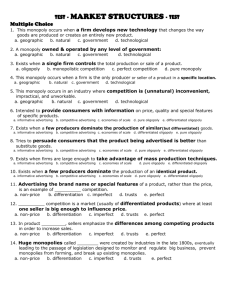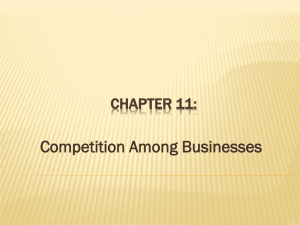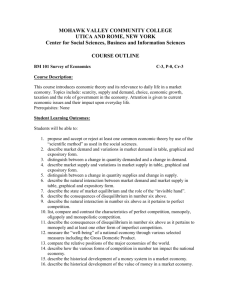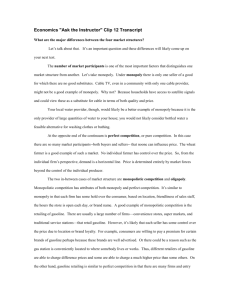Characteristics of Market Structure PERFECT
advertisement
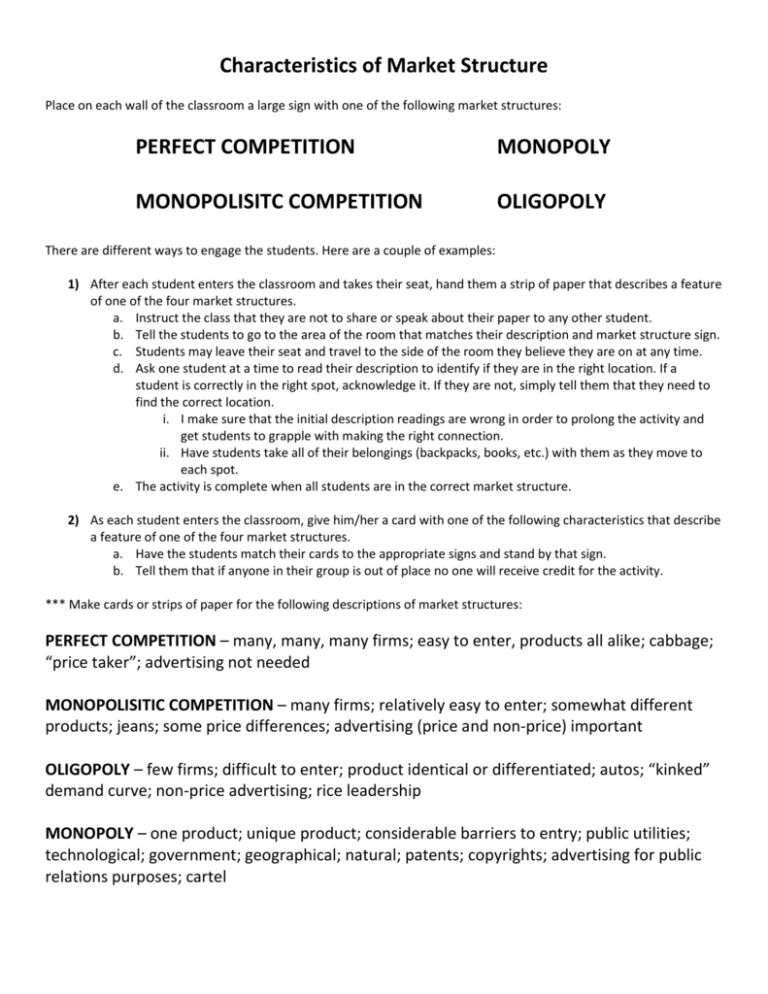
Characteristics of Market Structure Place on each wall of the classroom a large sign with one of the following market structures: PERFECT COMPETITION MONOPOLY MONOPOLISITC COMPETITION OLIGOPOLY There are different ways to engage the students. Here are a couple of examples: 1) After each student enters the classroom and takes their seat, hand them a strip of paper that describes a feature of one of the four market structures. a. Instruct the class that they are not to share or speak about their paper to any other student. b. Tell the students to go to the area of the room that matches their description and market structure sign. c. Students may leave their seat and travel to the side of the room they believe they are on at any time. d. Ask one student at a time to read their description to identify if they are in the right location. If a student is correctly in the right spot, acknowledge it. If they are not, simply tell them that they need to find the correct location. i. I make sure that the initial description readings are wrong in order to prolong the activity and get students to grapple with making the right connection. ii. Have students take all of their belongings (backpacks, books, etc.) with them as they move to each spot. e. The activity is complete when all students are in the correct market structure. 2) As each student enters the classroom, give him/her a card with one of the following characteristics that describe a feature of one of the four market structures. a. Have the students match their cards to the appropriate signs and stand by that sign. b. Tell them that if anyone in their group is out of place no one will receive credit for the activity. *** Make cards or strips of paper for the following descriptions of market structures: PERFECT COMPETITION – many, many, many firms; easy to enter, products all alike; cabbage; “price taker”; advertising not needed MONOPOLISITIC COMPETITION – many firms; relatively easy to enter; somewhat different products; jeans; some price differences; advertising (price and non-price) important OLIGOPOLY – few firms; difficult to enter; product identical or differentiated; autos; “kinked” demand curve; non-price advertising; rice leadership MONOPOLY – one product; unique product; considerable barriers to entry; public utilities; technological; government; geographical; natural; patents; copyrights; advertising for public relations purposes; cartel Extending the lesson --- The next step is to provide information and check for understanding for each market structure. 1) Distribute handout ‘Different Types of Market Structure’ a. Help students understand the difference among pure (or perfect) competition, monopolistic competition, pure oligopoly, differentiated oligopoly, and monopoly. Ask the following questions: i. What is the difference between homogeneous and differentiated products? (Homogeneous products are identical; differentiated products vary in quality and type. Raw cane sugar is homogeneous; candy bars are differentiated.) ii. What is the difference between pure competition and monopolistic competition? (Under monopolistic competition, products are differentiated and competition takes place in terms of both price and quality. In pure competition, products are identical and market forces set the price.) iii. Is monopolistic competition close to monopoly? (No. It is closer to pure competition because it has many firms.) iv. What are the main characteristics of oligopoly? (few firms, price leadership, barriers to entry.) v. What is the difference between pure oligopoly and differentiated oligopoly? (Pure oligopolists make identical products; differentiated oligopolists make products that compete a against each other in terms of quality.) vi. What are some examples of barriers to entry? (Large advertising costs, patents, licenses, high level of capital investment.) vii. What is the distinguishing characteristic of a monopoly? (Only one form in an industry or in a particular geographical area or in a particular market in which other firms are unable to compete.) b. Ask the students to fill in the last column of the handout with examples of each market structure. Discuss their answers. Possible answers follow: i. Pure competition: the wheat, corn, and other markets for agricultural products ii. Monopolistic competition: fast food, gasoline and other products sold at retail that have brand names iii. Pure oligopoly: steel, aluminum, oil, iv. Differentiated oligopoly: breakfast cereal, beer, soft drinks, toothpaste, soap, broadcasting, banks, medicinal drugs, chemicals v. Monopoly: electric utilities, gas utilities, local phone service DIFFERENT TYPES OF MARKET STRUCTURE Market Structure No. of Firms Type of Product Conditions of Entry Type of Price-setting Behavior Existence of Non-Price Competition Examples Student Handout DIFFERENT TYPES OF MARKET STRUCTURE Market Structure No. of Firms Pure (perfect) competition Type of Product Conditions of Entry Type of Price-setting Behavior Existence of Non-Price Competition Many Homogeneous Free or very easy Determined by market. None Monopolistic competition Many Differentiated Relatively Easy Determined by market plus small amount of discretion. Some, especially by advertising. Pure oligopoly Few Homogeneous Substantial barriers Determined by market plus considerable discretion. Possible price leadership. Some, such as on-time delivery. Differentiated Oligopoly Few Differentiated Substantial barriers Determined by market plus considerable discretion. Possible price leadership. Extensive Monopoly One Only product of its kind Entry can be blocked Establishes price at most profitable level possible. Advertising of firm’s “image” Examples PERFECT COMPETITION MONOPOLISITC COMPETITION OLIGOPOLY MONOPOLY




